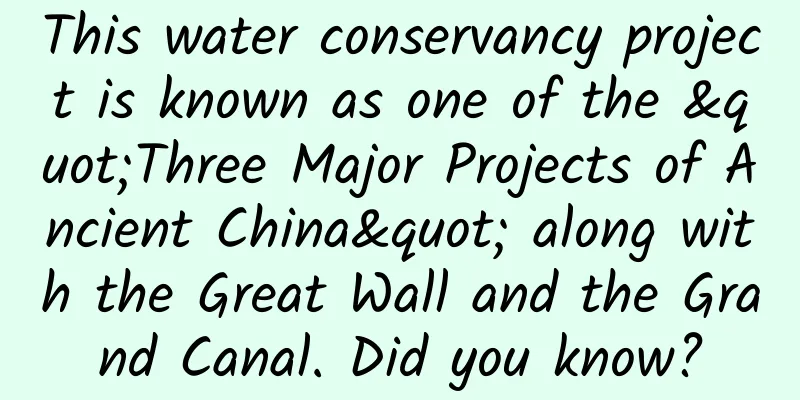This water conservancy project is known as one of the "Three Major Projects of Ancient China" along with the Great Wall and the Grand Canal. Did you know?

|
Karez With the Great Wall and the Grand Canal Also known as "Three Major Projects in Ancient China" Not long ago Zhejiang Satellite TV's "A Thousand Miles Alone" Season 3 Shan Jixiang, President of the Chinese Society of Cultural Relics Actors Zhou Yun, Tang Jiuzhou And the flying guests Wang Meng, Ai Re Come to the beautiful Turpan, Xinjiang Exploring the Mystery of Karez Shan Jixiang, Tang Jiuzhou, and Ai Re I also experienced going down the well myself. Go to the 17-meter-deep underground culvert Explore the source of life in Turpan Shan Jixiang said in an interview Karez in Turpan A total of more than 5,000 kilometers Equivalent to the length of the Yellow River In Turpan, which is short of water, rain and drought The sweetness of fruits and their unique culture All of them originated from the Karez With the karez The masses can live and work in peace and contentment Only then did we have oasis, culture, and tourism... Today we will Entering the Karez Learn about the story of the Karez What is a karez? When people step into the magical land of Xinjiang, they will find neatly arranged circular earth circles on the Gobi Desert at the edge of the Hami Oasis, like craters on the moon, one after another, leading from the foot of the Tianshan Mountains to the oasis. This is the "underground canal" in extremely arid areas, a great miracle created by mankind - the Karez. The Karez is an underground water conservancy project created by the working people in arid areas during the long history of development. The Karez brought out the groundwater, turning the desert into an oasis, and was called "well channel" in ancient times. The main working principle of the Karez is that people use the natural slope of the mountain to bring the large amount of rainwater, glaciers and snowmelt that seeps into the ground in spring and summer to the surface for irrigation to meet the production and living water needs of the desert area. - Baidu Encyclopedia Karez is a water conservancy system. It flows through underground channels and vertical shafts, then reaches Longkou, walks out of the ground, and reaches the flood dam. It is not that only vertical shafts are called Karez. - Shan Jixiang, President of the Chinese Society of Cultural Relics Karez is an ancient water conservancy facility, an artificial underground river that can bring the water that has melted from the snow in the mountains and seeped into the ground to the surface for people's daily production and life, so it is also called the "underground canal." - Li Gang, associate research librarian at the Xinjiang Turpan Research Institute Karez, which means "well hole", was recorded as early as in "Records of the Grand Historian". It was called "well channel" at that time. It is called "kariz" in Xinjiang Uyghur language, karez in Persian and khanet in Arabic. Who built the Karez? Regarding the origin of Karez, there are certain limitations in literature and archaeology. Many of them have no written records. It is also difficult to confirm the sites and relics because there are no written records. There are roughly three theories about the origin of Xinjiang Karez: Statement 1 Some scholars believe that the karez in Turpan appeared as early as the Han Dynasty 2,000 years ago, and its technology originated from the wells and canals in the Central Plains. This view was put forward by the famous scholar Wang Guowei, and was recognized by many scholars. Explanation 2 In ancient Persia, karez was already used as early as 500 BC. Afghanistan, Pakistan and Central Asian countries adjacent to Xinjiang all use karez. The karez technology in the ancient Western Regions was introduced from ancient Persia along the Silk Road at that time. Explanation 3 The karez in the Turpan Basin were created by the local ancient working people. This view is held by Uyghur scholars and famous karez craftsmen in the Turpan area. In recent years, more and more domestic scholars have also supported this view. Karez and Lin Zexu: When Lin Zexu passed through Turpan, he wrote about the Karez: "I saw many earth pits along the way. I asked their names and found out they were called 'Kajing'. They can lead water to flow horizontally from south to north, gradually leading it higher and higher. The water flows through the holes in the earth. It is truly incredible." After Lin Zexu was exiled to Xinjiang, he observed the people's sentiments and attached importance to agriculture and industry. He found that the karez was suitable for local agriculture, and then he promoted it vigorously and led the people to dig dozens of new karez. In order to commemorate Lin Zexu's contribution to promoting the karez, the local people called the karez "Lin Gongjing". Where are there karez? Is the karez only found in China? Of course not! But in China Karez is only found in Xinjiang ~~~ In China, karez are mainly distributed in Turpan and Hami, located on the southern foot of Bogda Mountain in eastern Xinjiang. They are also distributed in Qitai County, Muli County, Kuche County, Pishan County, Atushi and other places in Xinjiang. Worldwide, qanats are mainly distributed in central and western Asian countries and regions, such as Iran, Pakistan, Afghanistan, Saudi Arabia, northwest China, Kazakhstan, Uzbekistan, Kyrgyzstan, northwest India, Turkmenistan, Syria, Iraq, Oman, Libya, Jordan, Yemen, etc. There are also a small number of qanats in northern Africa, such as Egypt, Libya, Algeria, Tunisia, Morocco, etc. There are also very few qanats in Europe and America, such as southern Spain, Italy, Cyprus, Mexico, the United States, Chile, Peru, etc. Why build a karez? Turpan Basin is located in the arid area of my country, with the highest extreme temperature of 49.6℃, more than 100 days of strong winds of level 8 or above, and annual precipitation of less than 16 mm, while evaporation is as high as more than 3,000 mm. It is known as the "Fire Continent" and "Wind Repository". Here, eggs can be baked by burying them in the sand, and pancakes can be baked by sticking them to the wall. As a result, the Tang Dynasty frontier poet Cen Shen once wrote the following poem: "The fire clouds of the volcano are thick in May, and the fire clouds are condensed all over the mountain, and birds dare not come from thousands of miles away." Not only does Turpan have a very high absolute temperature, but it also has extremely little rainfall. There is no rain or snow for 10 months of the year. The annual precipitation is generally less than 16 mm, while the evaporation is as high as over 3,000 mm. The only precipitation that does fall is sometimes evaporated in the air before it even hits the ground. As a result, many areas here are even drier than "The Battle of Shangganling". Therefore, in Turpan, Xinjiang Water storage is particularly important There are many modern glaciers in Bogda Mountain in the north of Turpan Basin and Kalawucheng Mountains in both parts. When the snow melts in spring, water rushes down from the top of the mountain. In summer, due to the high mountains, the water vapor in the high altitude is intercepted, and heavy rain or rainstorms often occur in mountainous areas. There is little vegetation on the mountain ground here, and most of the ground is exposed bedrock. Rainwater quickly forms runoff on the surface and is transported to the center of the Turpan Basin. After entering the Gobi gravel belt, due to the strong permeability of the gravel, 50% of the water in some rivers flows into the underground, and some even seep into the underground, forming a huge water table at the edge of the basin. In ancient times, people in the Turpan Basin used the abundant groundwater and the slope of the terrain to ingeniously create the karez, which led the snow and rain water that seeped into the ground to the surface without any power, forming a year-round artesian water with low mineralization. Water flows underground, with less evaporation loss, stable water volume, and is not easily buried by wind and sand, making it very suitable for drinking by humans and animals, and can also be used to irrigate farmland. In short, the purpose of building karez is to avoid water evaporation and pollution, gather and guide groundwater, iceberg meltwater, rainfall and other water resources to the destination to supply production and life. What is the structure of a karez? The basic engineering structure of the karez is composed of vertical shafts, underground channels, water outlets, open channels and reservoirs. It is an ancient underground water conservancy project that cleverly utilizes the terrain slope and does not consume any power or resources to bring groundwater to the surface. Shaft A vertical shaft is a channel for transporting underground sand or silt when digging or cleaning the karez underground channel, and it is also a ventilation outlet. The depth of the shaft varies depending on the terrain and the height of the groundwater level. Generally, the closer to the source, the deeper the shaft is. The deepest shaft can reach more than 90 meters. The distance between vertical shafts varies with the length of the karez. Generally, there is a vertical shaft every 20 to 70 meters. Culvert The underground canal is the main project to bring shallow water from the underground aquifer to the surface. It is also called the underground canal and is the main body of the karez. The karez canal is divided into two parts: the water accumulation section and the water delivery section. The water sources of the karez canal can be divided into two types: field seepage and direct groundwater extraction. The length of the karez canal can be up to more than ten kilometers, and the shortest is only a few dozen meters or a few meters. Due to the high temperature and dryness in Turpan, the evaporation rate is large, and the water in the underground canals is not easily evaporated, and the water flowing underground is not easily polluted. In addition, the water flowing out of the underground canals is naturally filtered through thousands of layers of sand and gravel, and finally forms natural mineral water, which is rich in many minerals and trace elements. Local residents have been drinking it for hundreds of years, and many people live to be over 100 years old. Therefore, Turpan is known as the "Hometown of Longevity in China". Water outlet The outlet is the part where the water from the karez flows out of the ground from the underground channel. That is to say, because the terrain slope is greater than the underground channel water slope, the two parallel lines naturally intersect each other to form the outlet. Open Channel The open channel refers to the part from the outlet of the karez to the reservoir (reservoir). The function of the open channel is to transport the water flowing out of the outlet to the reservoir or farmland. The length of the karez open channel varies, generally ranging from 100 meters to 500 meters. Logging dam A reservoir is also called a water storage pond. A karez reservoir is a regulation project that regularly stores water, raises the temperature, and centralizes irrigation according to the amount of water in the karez. The area around a karez reservoir is often covered with lush greenery, attracting various organisms, improving the village's microecological environment, and solving the problem of water for human life and livestock drinking water. What are the advantages of karez? 1. Gravity irrigation, saving energy consumption In ancient times, there were no machines such as electric motors, diesel engines and water pumps, so it was impossible to extract groundwater from deep in the earth. The karez continuously delivered groundwater to farmland and orchards to irrigate crops. Today, the use of karez does not consume energy such as oil and electricity, and there is no cost for machines, so its operating costs are very low. 2. Reduce water evaporation loss Turpan is low-lying, with high temperatures and intense evaporation in summer, but the water from the karez flows entirely in dark caves, avoiding sunlight and reducing evaporation losses. 3. Prevent wind and sand from burying water supply buildings Once the wind blows in Turpan and other places, it will bring a lot of sand and bury the ditches. The karez is underground. As long as the vertical well mouth is sealed in time, the wind and sand cannot invade and the normal flow of irrigation water can be guaranteed. 4. Stable water volume and good water quality The water of the karez comes from groundwater, and the water volume is less affected by external factors. There is no flood or interruption of water flow due to cold weather and lack of snowmelt. Rotational irrigation can be organized according to the amount of water to ensure normal agricultural production. Karez are generally dug deep in the Gobi Desert, less polluted by human activities, and purified by sand and soil underground, so the water quality is good and suitable for drinking and irrigation. 5. The construction technology requirements are not high The construction technology of karez is not complicated. A craftsman can dig with a few ordinary workers using simple tools. The soil here is compact and not loose, which is suitable for digging deep wells. The tools used, such as planing hammers, hoes, earthworks, red willow baskets, etc., can all be made on site, without involving electric and pneumatic devices, and the process is simple. The scale of the karez There are more than 2,000 karez in Xinjiang, with a total length of over 5,000 kilometers, almost the length of the Yellow River. It is one of the largest and most complex underground water irrigation systems in the world. There are more than 1,100 karez wells recorded in history that run through Turpan’s underground blood vessels, of which 725 are still in existence, with an annual runoff of nearly 300 million cubic meters, exceeding the total runoff of the Huoyan Mountain water system. The best of Karez The oldest karez is Turkanerzi, located in Zhuangzi Village, Qiatkale Township, Turpan City. It is 3.5 kilometers long and can irrigate 20 mu of land every day. It was dug in 1520 and is nearly 500 years old. The longest karez: Hongtu Kanerzi in Shanshan County, with a total length of 25 kilometers and irrigating 58 mu of land per day; The deepest karez well: Nurmaiti Kanerzi, located in the east of Subexikan Village, Tuyugou Township, Shanshan, is 20.7 kilometers long, 98 meters deep, and can irrigate 25 mu of land per day. It was dug in 1900. The karez with the largest water volume is Outula Karez in Wulitoerkan Village, Aidinhu Township, Turpan City, which can irrigate 70 mu of land every day. "The karez and its water are life. It is the source of life.” "Loving the water from the Kaner Well is like loving a lover" These affectionate words This is the local people's evaluation of the karez “When drinking water, remember the well digger” Karez is a well-known ancient cultural heritage of the working people. The rare ones left Precious cultural heritage It has extremely high historical and scientific value. We need to pay more attention and protection! |
<<: Can't you supplement calcium by sunbathing through glass?
>>: When it comes to eating and drinking, you are not even as good as them.
Recommend
The State Administration for Market Regulation requires that the packaging of rice dumplings should not exceed 3 layers! What are the specific regulations? Attached is a minimalist method of making rice dumplings!
Zongzi is one of the foods celebrated during the ...
Comic: Human Code Evolution Illustrated Book
Reviewer: Luo Huiqian, Associate Researcher, Inst...
Why can't your interactive solution pass? Experts from big companies teach you these four methods!
This week, we specially invited Yi Yi, a former s...
Practical case: How to build a user churn warning system!
Instead of waiting for users to churn and then us...
The subscription account messages are unread, where are all the fans?
Most of the public account fans are losing contac...
No Internet Gene? Wanda E-commerce Still Raises Funds Rapidly
Wanda Group is becoming more and more like an Int...
Overseas video marketing promotion: YouTube influencer marketing guide!
YouTube is quickly becoming one of the most popul...
The core ideas and 14 practical methods of Weibo promotion
Weibo promotion uses Weibo as a promotion platfor...
How to write the URL of WeChat mini program? How to set the URL address of WeChat mini program?
Q: Does the external URL address for initiating r...
Scientists have found the cause of China's prehistoric floods. No wonder Dayu was successful in controlling floods
About 4,000 years ago, a flood rarely seen in the...
Introduction to home decoration space design
Starting from the basics, we will understand the ...
Redmi Note vs Honor Play Edition
In fact, users who pay attention to these two mobi...
It is the indispensable "magic weapon" to fight the epidemic!
Since the outbreak of the new coronavirus pandemi...
Why is it that only LeTV Super TV won the IFA Gold Award?
On September 2, Berlin, Germany, IFA, Europe'...
We are both doing ocpc, why is yours not producing enough volume and has no effect?
Optimizing oCPC is a challenge that must be faced...









